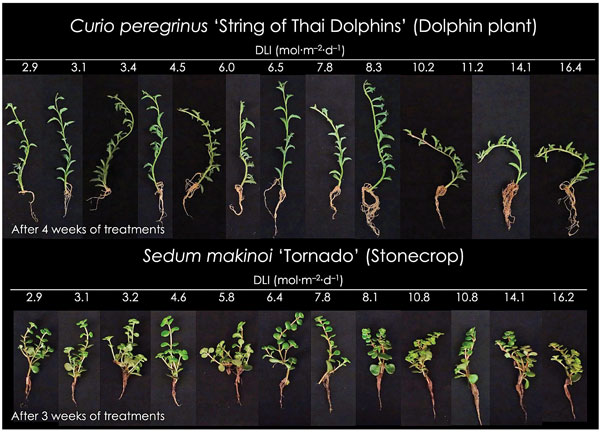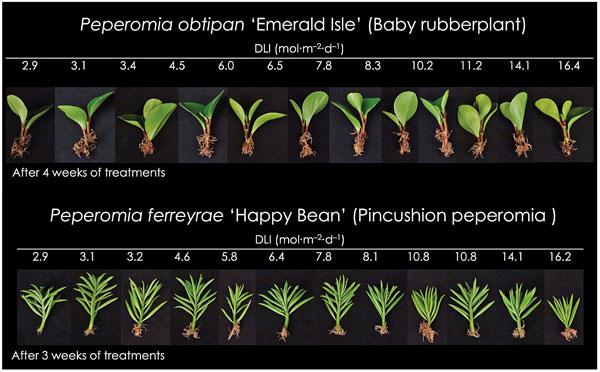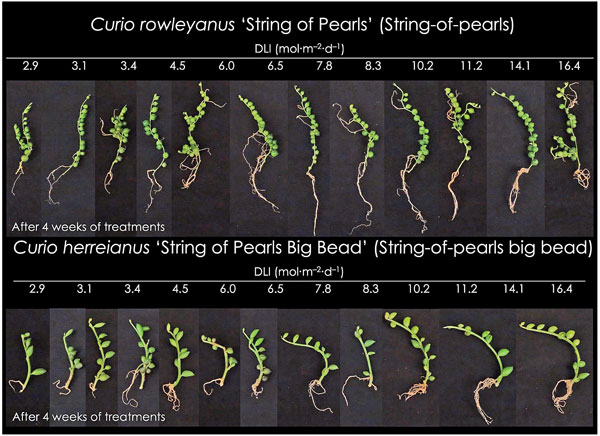6/1/2023
A Focus on DLI
Iro Kang & Roberto Lopez

Over the past four years, a new houseplant “craze,” “hysteria” and “hype” developed for indoor foliage plants due to the enthusiasm of Millennials and Gen Zers, social media and the COVID-19 pandemic lockdowns. This has led to a rise in sales and prices at all levels of the supply chain, prompting greenhouse growers across the United States, including those in northern latitudes, to focus on these once-forgotten plants.
A similar foliage boom occurred nearly 40 years ago when foliage sales increased by over 800% from 1970 to 1980. Given today’s exorbitant costs for heating, electricity, labor and transportation, propagation and production protocols are needed to produce these crops quickly and efficiently in temperate climates. Additionally, research is needed to investigate methods that can reduce rooting time and losses, while increasing the quality of young and finished plants.
Figure 1. Cuttings of dolphin plant and stonecrop under DLI ranging from 2.9 to 16.4 mol•m–2•d–1.
Foliage plants are commonly propagated through vegetative methods, such as shoot tip or node cuttings, grafting, division, layering and tissue culture. Regardless of the method, propagating them can be challenging and often time-consuming compared to annual and perennial bedding plants. The time it takes for foliage plants to root can vary based on the species, time of year, and environmental and cultural conditions in the propagation facility.
In this two-part series, we’ll share our results from research over the last two years where we’ve rooted tropical foliage and succulents under various daily light integrals (DLI) and root-zone temperatures to achieve uniform, complete and rapid rooting of foliage crop cuttings, which is crucial for the viability of this venture outside of warm climates such as Florida.
The experiment
Vegetative shoot tip cuttings of Curio rowleyanus String of Pearls (string-of-pearls), Curio herreianus String of Pearls Big Bead (string-of-pearls big bead), Curio peregrinus String of Thai Dolphins (dolphin plant), Sedum makinoi Tornado (stonecrop), Peperomia obtipan Emerald Isle (baby rubberplant), and Peperomia ferreyrae Happy Bean (pincushion peperomia) were harvested from stock plants. These cuttings were then stuck into 128-cell trays containing a prop-agation medium consisting of a mixture of 50% commercial substrate and 50% medium perlite, and without the use of a rooting hormone.
 The trays were divided into quarters (32-cell) and four trays of each cultivar were placed on a propagation bench in a glass-glazed greenhouse. The air temperature and root-zone heating were set at 75 and 81F (24 and 27C), respectively, and the trays were kept under these conditions for one week to callus. A vapor-pressure deficit (VPD) of 0.3 kPa was maintained through steam injection, and a target DLI of approximately 5 mol·m–2·d–1 was achieved by using 60% shade cloth and maintaining an 18-hour photoperiod from 4 a.m. to 10 p.m.
The trays were divided into quarters (32-cell) and four trays of each cultivar were placed on a propagation bench in a glass-glazed greenhouse. The air temperature and root-zone heating were set at 75 and 81F (24 and 27C), respectively, and the trays were kept under these conditions for one week to callus. A vapor-pressure deficit (VPD) of 0.3 kPa was maintained through steam injection, and a target DLI of approximately 5 mol·m–2·d–1 was achieved by using 60% shade cloth and maintaining an 18-hour photoperiod from 4 a.m. to 10 p.m.
Figure 2. Cuttings of baby rubberplant and pincushion peperomia under DLI ranging from 2.9 to 16.4 mol•m–2•d–1.
After one week, one tray of each cultivar was randomly assigned to four different DLI treatments. The trays were placed under shade cloth providing ≈70%, ≈50%, ≈30% or ≈0% (no shade). The air and root zone temperature, daylength and VPD were maintained at 70F (21C), 75F (24C), 18-h (4 a.m. to 10 p.m.), and 0.3 kPa, respectively.
Stonecrop and pincushion peperomia were harvested after three weeks under DLI treatments, while dolphin plant, string-of-pearls, string-of-pearls big bead and baby rubberplant were harvested after four weeks. This experiment was repeated three times resulting in DLIs ranging from very low (2.9 mol·m–2·d–1) to very high (16.4 mol·m–2·d–1).
Our findings
The root dry mass of each genus and cultivar, which is a measure of the good root growth and development, was affected differently by DLI. The dolphin plant and baby rubberplant exhibited a significant increase in root dry mass by 376% and 50%, respectively, as DLI increased from 2.9 to 16.4 mol·m–2·d–1 (Figures 1 and 2). However, the root dry mass of stonecrop, pincushion peperomia, string-of-pearls and string-of-pearls big bead were unaffected by DLI during rooting (Figures 1, 2 and 3).
Generally, the shoot dry mass of most genera we investigated increased as the DLI increased. For instance, the shoot dry mass of pincushion peperomia and baby rubberplant increased by 6% (12.3 mg) and 189% (595.9 mg), respectively, as DLI increased from 2.9 to 16.4 mol·m–2·d–1 (Figure 2).
 Similarly, the total dry mass of stonecrop, baby rubberplant, dolphin plant, string-of-pearls and string-of-pearls big bead increased as DLI increased from 2.9 to 16.4 mol·m–2·d–1 (Figures 1, 2 and 3). For example, the total dry mass of stonecrop and string-of-pearls increased by 143% (157.6 mg) and 185% (125.5 mg), respectively, as DLI increased (Figures 1 and 2).
Similarly, the total dry mass of stonecrop, baby rubberplant, dolphin plant, string-of-pearls and string-of-pearls big bead increased as DLI increased from 2.9 to 16.4 mol·m–2·d–1 (Figures 1, 2 and 3). For example, the total dry mass of stonecrop and string-of-pearls increased by 143% (157.6 mg) and 185% (125.5 mg), respectively, as DLI increased (Figures 1 and 2).
Figure 3. Cuttings of string-of-pearls and string-of-pearls big bead under DLI ranging from 2.9 to 16.4 mol•m–2•d–1.
During propagation, the rooted cutting stem length and diameter were influenced differently. String-of-pearls, string-of-pearls big bead, dolphin plant and baby rubberplant were most compact at a DLI of 2.9 mol·m–2·d–1 (Figures 1, 2 and 3). On the other hand, the most compact stonecrop and pincushion peperomia rooted cuttings were those propagated under a DLI of 16.4 mol·m–2·d–1 (Figures 1 and 2). Although the stem diameter of pincushion peperomia, dolphin plant and baby rubberplant increased as DLI increased by 14% (0.49-mm; pincushion peperomia) to 77% (1.08-mm; dolphin plant), the stem diameter of stonecrop, string-of-pearls and string-of-pearls big bead was reduced as DLI increased (Figures 1, 2 and 3).
Based on our research, shoot and total dry mass of most curio, peperomia and sedum species increased as DLI increased from 2.9 to 16.4 mol·m–2·d–1, while DLI had a minimal impact on root dry mass. These results differ in what is often observed during vegetative shoot-tip propagation of annual bedding plants, herbaceous perennials and culinary herbs. For these crops, as DLI during rooting increases, root dry mass increases and therefore rooting time can be reduced by up to three weeks. Addition-ally, rooted cuttings are more compact and have thicker stems when propagated under higher DLIs.
Therefore, we recommend that a DLI between 6 to 10 mol·m–2·d–1 is maintained during rooting of foliage plants as further increases have minimal impact on rooting time, root dry mass, and stem length and diameter. GT
Acknowledgements: We thank J.R. Peters for fertilizer; Dümmen Orange, Henry Mast and Kalamazoo Specialty Plants for plant material; East Jordan Plastics for trays; and the American Floral Endowment, MSU Project GREEEN, the Western Michigan Greenhouse Association and the Metro Detroit Flower Growers Association for funding.
Roberto Lopez is an Associate Professor and Controlled Environment/Floriculture Extension Specialist, and Iro Kang is a Ph.D. student in the Department of Horticulture at Michigan State University.